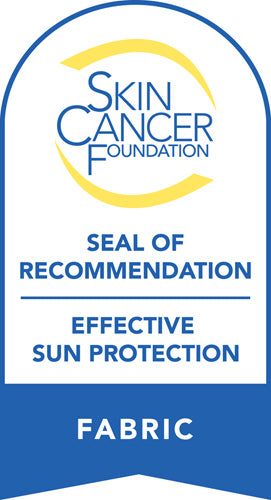Sun Protection Strategies: Ways to Reduce Your Risk of Skin Cancer
More than 9,500 people in the US are diagnosed with skin cancer every day according to the the Skin Cancer Foundation. Left unchecked, even minor issues can evolve into far greater complications.
Staying safe under the sun requires more than just staying in the shade. Sun protection strategies, like wearing UV-protective clothing and limiting exposure during peak hours, play a vital role in reducing skin cancer risks. Below, we'll explore some of the most notable benefits of wearing UV-blocking clothing.
Lowering the Risk of Skin Cancer
Skin cancer risks are significantly heightened by prolonged sun exposure. Wearing sun protection clothing is one of the simplest ways to guard your skin against harmful rays. Protective fabrics provide consistent coverage during your time outdoors.
By blocking most UV radiation, these garments can greatly reduce skin cancer risks over time. Choosing reliable clothing with built-in UV shielding demonstrates a proactive approach to long-term skin health.
Preventing Sunburns with Effective Coverage
Sunburns can lead to discomfort and long-term skin damage, but protective clothing minimizes these risks. Materials designed with a high ultraviolet protection factor (UPF) rating serve as a reliable barrier against the sun's intense rays. Investing in UPF clothing ensures better coverage for exposed areas of the body.
Effective garments protect delicate skin regions, such as the shoulders and back, where burns are common. Staying protected with high-quality fabrics prevents painful sunburns during outdoor activities.
Providing All-Day Sun Protection
Long outdoor days expose the skin to cumulative UV radiation. High-quality garments offer consistent protection without fading throughout the day. Sun protection clothing is particularly beneficial for people who spend extended periods outdoors.
Unlike other methods, which may wear off, durable fabrics shield against ongoing exposure. With reliable clothing, you can focus on enjoying outdoor activities while staying safe.
Convenient Skin Protection
Clothing designed for sun safety offers a dependable way to keep your skin protected all day. High-UPF fabrics maintain their protective qualities without the need for touch-ups.
Using such materials simplifies sun safety routines, especially during active outings. UV ray damage can accumulate quickly, but reliable fabrics provide all-day shielding. Choosing garments that eliminate frequent product reapplication makes skin care more convenient and effective.
Enhancing Comfort in Sunny Conditions
Hot, sunny days often lead to discomfort, but lightweight protective clothing keeps you cool. Breathable fabrics with UPF ratings shield your skin without causing overheating.
Sun-safe fashion combines functionality with style, offering comfort while safeguarding your health. Protecting your skin doesn't have to feel restrictive when you wear thoughtfully designed apparel.Embracing protective clothing ensures a comfortable and sun-safe experience in any environment.
Defending Against Premature Skin Aging
UV exposure is one of the leading causes of early signs of skin aging, such as wrinkles and dark spots. Protective clothing with a high UPF rating helps block harmful rays before they can penetrate the skin.
Over time, consistent use of these garments can preserve your skin's elasticity and youthful appearance, as sun-protective fabrics offer a dependable barrier throughout the day. By reducing UV ray damage, you can maintain healthier, more resilient skin as you age.
Finding a Reputable Supplier
Choosing the right supplier for UV-protective clothing is essential for getting high-quality products. A reputable supplier provides garments that meet strict standards for blocking harmful rays and protecting your skin. Below are the key attributes to consider.
Fabric Quality
High-quality fabrics play a crucial role in effective sun protection. Durable materials with tightly woven designs are better at blocking harmful UV rays. Lightweight yet strong fabrics offer a balance between comfort and protection.
Some suppliers provide samples or detailed descriptions to help evaluate their products. Investing time in examining fabric quality helps you choose garments that will last and perform well.
Customer Reviews
These offer valuable insights into a supplier's reputation and product performance. Honest feedback from other buyers highlights both the strengths and potential drawbacks of their offerings. A consistent pattern of positive reviews often signals a trustworthy supplier.
Pay attention to comments about durability, comfort, and UV protection effectiveness. Negative reviews, on the other hand, can alert you to avoid unreliable suppliers. It's also crucial to keep an eye out for fake reviews during your search.
UPF Ratings
UPF ratings measure how effectively a fabric blocks ultraviolet radiation. Higher UPF ratings provide stronger protection, reducing the risk of skin damage.
Reputable suppliers typically display this information clearly for their products. Comparing the ratings across different garments helps you choose the right level of protection for your needs. A supplier that prioritizes transparency about UPF ratings shows they value customer safety.
Compare Price and Value
Pricing alone doesn't reflect the true value of UV-protective clothing. A higher price tag may indicate superior materials or better craftsmanship, but it's essential to confirm these claims. Comparing prices across suppliers can help identify reasonable rates for high-quality garments.
Balancing cost with durability and effectiveness ensures you're making a smart investment. A fair price for reliable protection is worth prioritizing over cheaper, less effective alternatives.
Return Policies
Understanding a supplier's return policy protects you from being stuck with unsatisfactory products. Clear and customer-friendly policies indicate a supplier is confident in their offerings.
Reading the fine print can reveal important details, such as time frames and conditions for returns or exchanges. A flexible policy makes it easier to correct mistakes or resolve issues with your purchase. Choosing a supplier with a solid return policy adds an extra layer of confidence to your buying experience.
Product Variety
A diverse product range allows you to find clothing that meets both your style and protection needs. Suppliers offering multiple options often cater to different preferences, from lightweight shirts to full-coverage gear.
Exploring their inventory can uncover innovative designs or features that suit your lifestyle. Limited options may signal a lack of specialization or commitment to quality. Selecting a supplier with a wide selection ensures you'll find the right fit for your needs.
Fabric Technology and Innovation
Innovative fabric technology plays a key role in providing effective sun protection. Advanced materials designed for UV safety block harmful rays without relying on chemical treatments.
High-quality fabrics maintain their protective properties even after multiple washes, ensuring long-term effectiveness. Breathability and softness add to the appeal, offering comfort alongside innovation.
Moisture-Wicking and Quick-Dry Features
Moisture-wicking fabrics keep you dry and comfortable by pulling sweat away from the skin. Quick-drying materials enhance this effect, ensuring you stay cool during intense activities. These technical features are especially valuable for outdoor enthusiasts and athletes who require reliable performance.
Fabrics with these properties often provide a cooling effect, improving overall comfort in warm conditions. Sun-protective garments with moisture management offer a practical and enjoyable solution for active lifestyles.
Environmental Impact and Sustainability
Sustainable production methods prioritize the environment while delivering high-quality sun-protective clothing. Eco-friendly fabrics avoid harmful chemicals, reducing their impact on ecosystems while minimizing carbon footprint during production.
Companies focusing on sustainability often use ethical manufacturing practices, ensuring both product quality and responsibility. Long-lasting materials also contribute to environmental efforts by reducing waste over time. Supporting brands with a sustainability focus promotes both personal safety and global well-being.
Signs of Skin Cancer
Recognizing the signs of skin cancer early can make a significant difference in treatment outcomes. Warning signs can identify potential issues and prompt you to seek medical attention. Below, we'll take a closer look at them.
Changes in Mole Shape or Size
A potential early sign of skin cancer is the presence of moles that change:
- Shape
- Size
- Color
Pay attention to moles that grow larger, develop irregular borders, or take on uneven tones. Even subtle changes in their appearance can be significant and worth discussing with a dermatologist.
New moles appearing in adulthood or existing ones becoming raised or lumpy may also signal a concern. Regular self-checks are an important step in identifying these changes early.
Appearance of New Growths
Unexpected growths on the skin, especially those that look unusual, could indicate a problem. These growths often differ in texture, color, or appearance compared to surrounding skin. While not all new growths are harmful, those that persist or evolve should be evaluated.
Early detection and treatment can prevent more serious complications. Seeking professional advice for new or unusual skin features is always a prudent step.
Sores or Lesions That Don't Heal
Sores or lesions that don't heal after a few weeks may be a sign of skin cancer. Such areas might:
- Ooze
- Bleed
- Remain tender without improving
Persistent sores are particularly concerning when they develop in sun-exposed areas like:
- Face
- Hands
- Arms
Seeking medical advice for any wound that refuses to heal is critical for timely diagnosis. Addressing these signs early improves the chances of successful treatment.
Unusual Itching or Tenderness
Skin that feels unusually itchy or tender in specific areas could be signaling a deeper issue. Persistent sensations without a clear cause, such as a rash or irritation, warrant further examination.
Sometimes, these symptoms occur alongside other changes, such as discoloration or the emergence of a growth. Ignoring chronic discomfort can delay the detection of more serious conditions. Consulting a professional ensures symptoms are addressed before they worsen.
Bleeding or Crusting Lesions
Lesions that bleed or develop a crusty surface may indicate an underlying problem. Skin cancer lesions often fail to heal and may alternate between bleeding and scabbing.
Such features are typically more noticeable in areas frequently exposed to the sun. Paying attention to changes in these lesions, especially if they reoccur, is vital. Prompt evaluation can prevent further progression and allow for more effective treatment.
Variations in Skin Texture
Unexplained changes in skin texture may be early signs of skin cancer, such as areas becoming:
- Rough
- Scaly
- Thickened
Affected spots often feel different to the touch compared to the surrounding skin. These changes can appear anywhere on the body but are more common in sun-exposed areas.
Being aware of shifts in how your skin feels or looks can help catch potential issues sooner.Regular skin checks make it easier to spot such variations early.
Taking Action
Taking prompt action when you notice skin changes can help you get the ideal treatment for your situation. Don't hesitate to contact a medical professional when necessary. Below, we'll explore the key ways you can address potential skin cancer signs.
Scheduling a Medical Evaluation
Acting quickly to schedule a medical appointment is essential when you notice unusual skin changes. A dermatologist can examine suspicious areas and determine if further testing is necessary.
Early evaluation often leads to a better understanding of your condition and potential treatment options. Make an effort to find a doctor experienced in diagnosing and treating skin cancer for a more thorough assessment. Waiting too long can allow issues to progress, making early diagnosis a critical step.
Documenting Skin Changes
Keeping a detailed record of skin changes helps provide valuable information to your doctor. Photos taken over time can show how a mole or lesion has evolved.
Writing down observations, such as when changes began or if symptoms like itching or bleeding occurred, can support a more accurate diagnosis. Consistency in tracking these details allows your dermatologist to identify patterns or concerns more effectively. A well-documented history of changes also strengthens the overall evaluation process.
Preparing Questions for Your Doctor
Going into your appointment with prepared questions helps you address concerns and gain clarity about your condition. Asking key questions can guide your next steps, such as ones about:
- The significance of your symptoms
- The need for additional tests
- Potential treatment options
It's also helpful to inquire about preventive measures to reduce future risks. Engaging in an open dialogue with your doctor encourages better understanding and collaboration in managing your health. Being well-prepared for the discussion ensures you leave with the answers you need.
Never Neglect UV-Blocking Clothing
Utilizing UV-blocking clothing is a critical step in reducing the risk of skin cancer. By taking early action and consistently using protection, you can maintain healthy, resilient skin for years to come.
BloqUV offers UPF 50+ sun-protective activewear, blocking 98% of the sun's rays with their proprietary BloqTek™ fabric. Founded in 2009, their moisture-wicking, quick-drying apparel provides instant sun protection, unaffected by laundering, ensuring comfort and safety for outdoor enthusiasts. You can check out our catalog of new arrivals today to learn more about how we can help.



